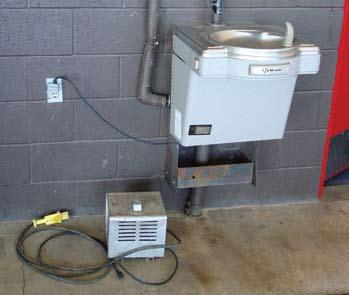
6 minute read
Good, Bad and Ugly
Good Great message with an interesting approach.
Ugly
Advertisement
Where is that eye wash station?
Bad
What do you get when you store and use an electric-cart charger with a damaged equipment plug in an aircraft hangar by a water fountain in a high-traffic area?
If you’re lucky, all you get is your picture in the BAD section of Mech magazine.

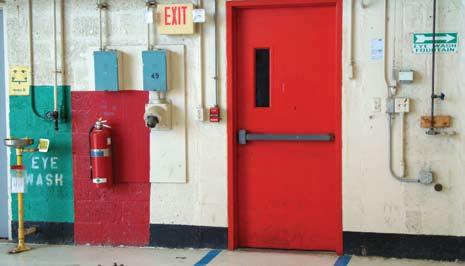
for the Maintainer
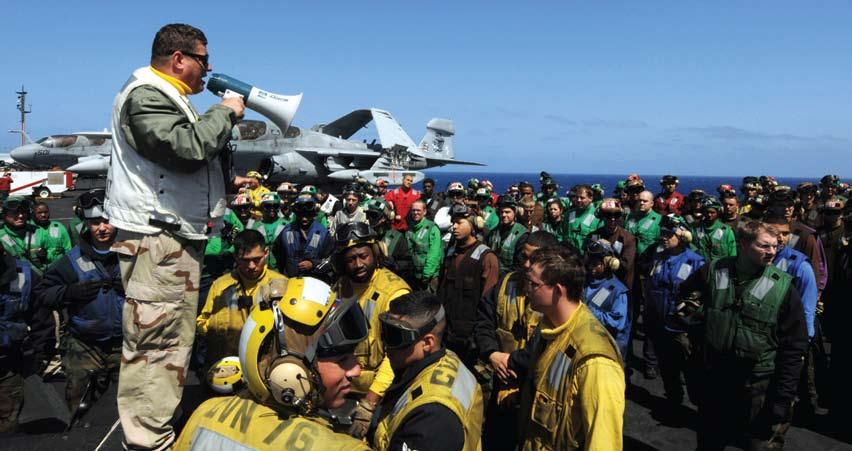
By Ted Wirginis and Denis Komornik
We almost seamlessly maintain and repair aircraft and equipment all over the fleet, but did you ever wonder how we do this? Simply put, it’s because we have very dedicated professionals doing their job. Whether we realize it or not, though, the success of those individuals who are just “doing their job” hinges upon thorough application of Operational Risk Management. Three levels are involved:
In depth, when our leadership and acquisition folks provide the equipment, training and guidance for maintenance actions
Deliberate, when we plan and brief for the events or operations of the day
Time critical, when we actually apply the risk controls or use the resources provided to us for getting the job done.
If you look back at the fall 2008 issue of Mech, you will see a familiar diagram (Figure 1) that shows the
Navy photo by MC2 Joseph Buliavac
three levels in a shaded gradient, with no definitive lines between the levels. One level flows to next, dependent upon the time available, which obviously decreases as we get closer to the point of executing a maintenance action. We spend most of the time doing the job; that means managing risk and resources at the time-critical level.
Why is it important to understand the three levels of ORM? Because each level plays a role in improving our chance of completing the mission. In particular, the controls developed at each level are resources we can tap into to accomplish our job or mission during its execution. These resources make it easier to do our job and help catch errors that might interfere with the task or prevent mission success. Beyond the equipment itself and our fellow shipmates, there are other resources available to help mitigate risks associated with routine and expedited maintenance. These resources broadly can be
Figure 1 categorized into the following blocks: • Policies, procedures, and routines, such as general orders, SOPs and guides. These resources speed up decision-making and increase predictability through standardized operations. • Checklists and job aids, such as instructions and MIMs. These resources decrease potential for error and improve coordination. • Automation, such as alarms, warning lights, and lock-out warnings. They alert us, help us interpret and process information more quickly, and help distribute the workload. • Briefings and external resources transfer situational awareness from a supervisor, shipmate, briefer, or crew member. Briefs establish expectations and improve situational awareness. • Knowledge, skills and techniques, such as training, practice and drills. These resources are brought by the individual to the task or mission. Besides helping us do a particular task, knowledge and skills improve situational awareness and ability to make informed decisions.
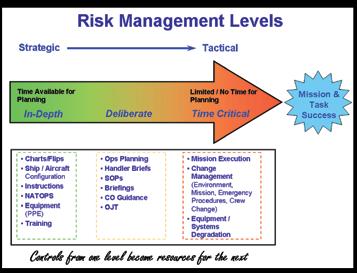
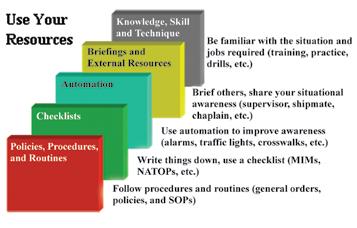
Figure 2
We can draw on these resources, created as controls, during the in-depth and deliberate levels of risk management to help us execute the task or mission at the time-critical level. Those in a leadership position are responsible to make sure the resources are available to maintainers who will be doing the tasks.
It is essential to continuously review available resources and make sure they are current, effective and relevant. This is a critical component of managing risk.
Don’t think of ORM as an added program to do the job; it’s an integral part of warfighting. We need to think, plan and perform better than our enemy to win or to succeed. We need to understand the threats and hazards we face—the things that stand in the way of successfully accomplishing our missions. We prepare to go into battle by developing tactics and procedures to counter our adversaries, and then we hone the skill necessary to execute them. We need to do our jobs, sometimes under extreme stress, and we need to do it as a team.
Figure 3
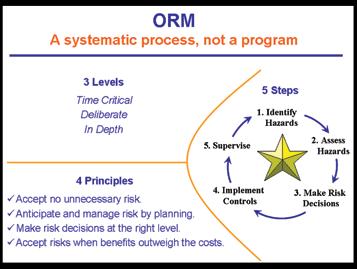
How does ORM fit into our daily lives when most of the time we’re told what to do, when to do it, and that we’d better hurry up and do it? That’s when we should apply time-critical risk management.
Recall the five-step process of ORM (Figure 3). This is the fundamental process used to anticipate hazards and to develop controls to mitigate the associated risks before doing the job. Time and experience has shown that it works exceptionally well for the in-depth and deliberate levels, but is a challenge, at best, to apply at the time-critical level. To help fill this time-critical gap, we have developed a new tool. You can read about it in the next issue of Mech.
Mr. Wirginis is the ORM manager and Mr. Komornik is the ORM training and education specialist at the Naval Safety Center.
PMA260 Aviation Support Equipment

By LCdr. John Ruane
The Naval Air Systems Command (NAVAIR) serves the Nation and the Navy by developing, acquiring, and supporting naval aeronautical and related technology systems.
PMA260 is a program-management office in Air 1.0, which, led by Capt. Mike Belcher, procures and provides life-cycle support for all common support equipment used by each type-model-series aircraft throughout the Navy and Marine Corps. This inventory encompasses more than 2,500 line items of support equipment. PMA260 currently manages more than 50 designated acquisition programs including the consolidated automated support system (CASS) (Navy) and RTCASS (Marine Corps). More than 60 military, federal and contractor personnel work at NAVAIR headquarters in Patuxent River, Md., while the rest of the PMA260 team works at six other sites throughout the country.
PMA260’s mission is to provide cost-effective, aviation-common support equipment for fleet operations and maintenance activities. They also fund requirements for replenishing peculiar support equipment (PSE) for out-of-production weapon systems. The scope of their mission includes 157 funded programs across the 5 year budget with 124 current contracts in place. These contracts cover modernizing CASS; procuring new hydraulic power-supply systems and a new land-based, mid-range tow tractor; and developing 45 abbreviated acquisition programs.
PMA260’s additional responsibilities include: • Providing support-equipment leadership for the naval-aviation enterprise • Serving as DoD Executive directorate for automatic test systems
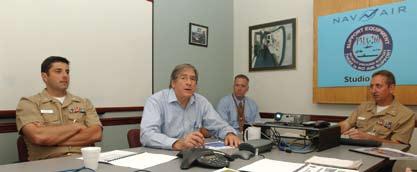
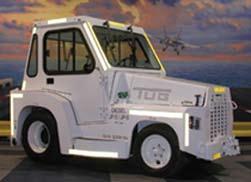
• Serving as a member of the joint panel for aviation-support equipment (JPAVSE) committee, aviation common systems (ACS) committee, and joint aeronautical logistics commanders (JALC) • Managing AUTOSERD and SERMIS, which includes all SE and IMRL gear • Being designated as a USD(AT&L) reduction of total ownership cost (RTOC) special interest program
They support the fleet, providing the tools needed to fix, service, arm, and handle aircraft. In other words, PMA260 provides every type of ground support necessary to meet requirements of the daily flight schedule










